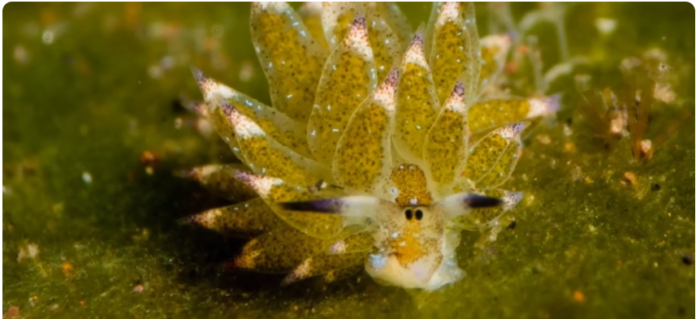
The ocean is a most mysterious place in the world , home to many strange creatures. These include the Leaf Shape Slug, a tiny and small sea slug that looks like a cartoon character brought to life. In this blog post, we’ll dive deep into the world of the leaf sheep slug, exploring what makes it unique and interesting.
What is a Leaf Sheep Slug?
The leaf shape slug, also known by its scientific name Costacella kuroshima, is a small and tiny sea slug belonging to the order Sacoglossan. Sacoglossans are often called “sap-sucking” slugs because they feed on algae, extracting plant sap. What sets the leaf shape slug apart from other sea slugs is its striking shape and ability to harness the power of photosynthesis.
Appearance: A Cartoon Character Come to Life
Leafhopper slugs are small, usually about 5 mm in length. Despite its small size, it has a wonderful appearance. Its body is covered with leaf-like appendages called serrata, which give it a plant-like appearance. These serrata are green, making the slugs resemble little cartoon sheep grazing on underwater pastures. The Leaf Shape Slug’s head has two black eyes and a pair of horns that look like sheep’s ears, adding to its elegant and whimsical appearance.
Habitat: Where Can You Find the Leaf Sheep Slug?
Leaf shape slugs are found in the Indo-Pacific region, particularly in shallow waters around Japan, the Philippines, and Indonesia. They thrive in areas that have plenty of algae, which is their main food source. These slugs are often found on algae-covered rocks and coral reefs, where they blend in perfectly with their surroundings.
Unique Abilities: Photosynthesis in Animals
One of the most interesting aspects of the leaf-shaped slug is its ability to perform photosynthesis, a process normally associated with plants. When a slug eats algae, it doesn’t just eat plant nutrients. It also absorbs algae’s chloroplasts, the structures that enable photosynthesis. These chloroplasts are stored in the serrata of the slug, allowing it to convert sunlight into energy.
This unique ability, known as kleptoplasty, is incredibly rare in the animal kingdom. Leaf shape slugs become primarily solar powered, supplementing their diet with energy from sunlight. This adaptation not only helps the slug survive in nutrient-poor environments, but also makes it a subject of interest to scientists studying the potential of photosynthesis in animals.
Diet Or Food : What Do Leaf Sheep Slugs Eat?
As mentioned earlier, leafhopper slugs feed primarily on algae. They use a specialized mouthpart called a radula, which acts like a tiny rasp, to scrape off algae cells. By feeding on algae, the slug obtains not only nutrients but also chloroplasts necessary for photosynthesis. This diet is critical to the leaf shape slug’s survival and its ability to harness solar energy.
Reproduction : How Do Leaf Sheep Slugs Reproduce?
Leaf shape slugs are hermaphrodites, meaning each individual has both male and female reproductive organs. This allows any two slugs to mix and exchange genetic material. After mating, slugs lay eggs in clusters on algae. These eggs hatch into larvae, which eventually settle on algae and become adult slugs. Reproduction ensures the continuation of these fascinating creatures in their natural habitat.
Conservation: Protecting the Leaf Sheep Slug
Although the leaf swarm slug is not currently considered endangered, it faces threats from habitat destruction and pollution. Coral reefs and algal beds, where these slugs live, are under pressure from human activities such as coastal development, pollution and climate change. Protecting these habitats is critical to the survival of leafhopper slugs and countless other marine species.
Fun Facts About the Leaf Sheep Slug
- It’s also called a “Shaun the Sheep” sea slug due to its resemblance to the popular cartoon character.
- The green color of the leaf sheep slug comes from the chloroplasts it absorbs from algae.
- Leaf sheep slugs are one of the few animals capable of kleptoplasty.
- They are often found at depths of 1 to 20 meters, making them relatively accessible to divers.
- Despite their small size, leaf sheep slugs play a significant role in the marine ecosystem by helping control algae growth.

FAQs About Leaf Sheep Slugs
1. How big do leaf sheep slugs get?
Leaf sheep slugs are very small, typically growing to about 5 millimeters in length. Some individuals may grow slightly larger, but they are generally tiny creatures.
2. Why are they called leaf sheep slugs?
They are called leaf sheep slugs because their cerata look like tiny leaves, and their faces resemble that of a sheep. The combination of these features gives them a unique and adorable appearance.
3. Can leaf sheep slugs really perform photosynthesis?
Yes, leaf sheep slugs can perform photosynthesis. They absorb chloroplasts from the algae they eat and use them to convert sunlight into energy, similar to how plants do.
4. Where can I see leaf sheep slugs?
Leaf sheep slugs are found in the Indo-Pacific region, particularly around Japan, the Philippines, and Indonesia. They live in shallow waters on algae-covered rocks and coral reefs.
5. Are leaf sheep slugs endangered?
Leaf sheep slugs are not currently considered endangered, but their habitats are at risk due to pollution, coastal development, and climate change. Conservation efforts are essential to protect these unique creatures and their environments.
Finally, the leaf-shaped slug is a remarkable example of nature’s creativity and adaptability. Its unique appearance, fascinating abilities, and important role in marine ecosystems make it a creature worth learning about and protecting. Whether you’re a marine biologist or just someone who likes to discover new and interesting animals, the Leaf Shape Slug is sure to capture your imagination.

